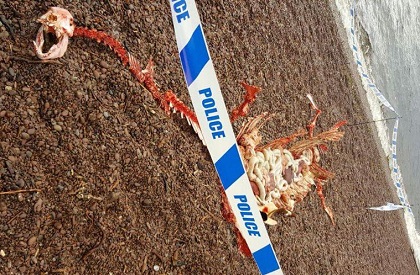Longtime readers of this blog know that I've been pushing my hypothesis (note: not "theory") regarding the identity of the Loch Ness Monster for years. I think that the monster is a sturgeon, based on a number of recent pieces of evidence. Monster hunter Steve Feltham, who I covered about a year ago, likewise believes that the monster is a fish, but he has a different candidate in mind - the Wels Catfish, a large fish that was introduced into the loch as a sport fish during the Victorian era.
This last week, it seemed as if the discovery of a mysterious set of remains on the shore of the loch might shatter both of those explanations. They appeared to be those of a dinosaur-like creature that clearly was no fish. But the discovery turned out to be not quite what anyone expected.
So the catfish versus sturgeon debate is still alive and well. While the Wels Catfish is a good candidate on the grounds that it is known to live in the loch and sturgeons are not, a number of the photos I have seen suggest a longer fish. The Wels Catfish grows to about nine feet, whereas the European Sea Sturgeon can grow to more than twice that long. At the same time, European Sea Sturgeons are critically endangered, while Wels Catfish are relatively common.
So until somebody comes across a real specimen as opposed to a fake one, the debate will go on over the monster's identity.
This last week, it seemed as if the discovery of a mysterious set of remains on the shore of the loch might shatter both of those explanations. They appeared to be those of a dinosaur-like creature that clearly was no fish. But the discovery turned out to be not quite what anyone expected.
An animal rescue charity posted the images on its Facebook page saying that a dog walker had found the remains next to Loch Ness.
People across the globe were this morning mourning the apparent loss of the once-mythical beast.
Some, however, have called into question the veracity of the image saying it is strange that the skeletal remains still had the internal organs intact.
Surely they would have been eaten/rotted away with the rest of the flesh?
Help2Rehome Scotland later poured water on all and any theories saying it was actually set out for a TV show.
So the catfish versus sturgeon debate is still alive and well. While the Wels Catfish is a good candidate on the grounds that it is known to live in the loch and sturgeons are not, a number of the photos I have seen suggest a longer fish. The Wels Catfish grows to about nine feet, whereas the European Sea Sturgeon can grow to more than twice that long. At the same time, European Sea Sturgeons are critically endangered, while Wels Catfish are relatively common.
So until somebody comes across a real specimen as opposed to a fake one, the debate will go on over the monster's identity.


No comments:
Post a Comment